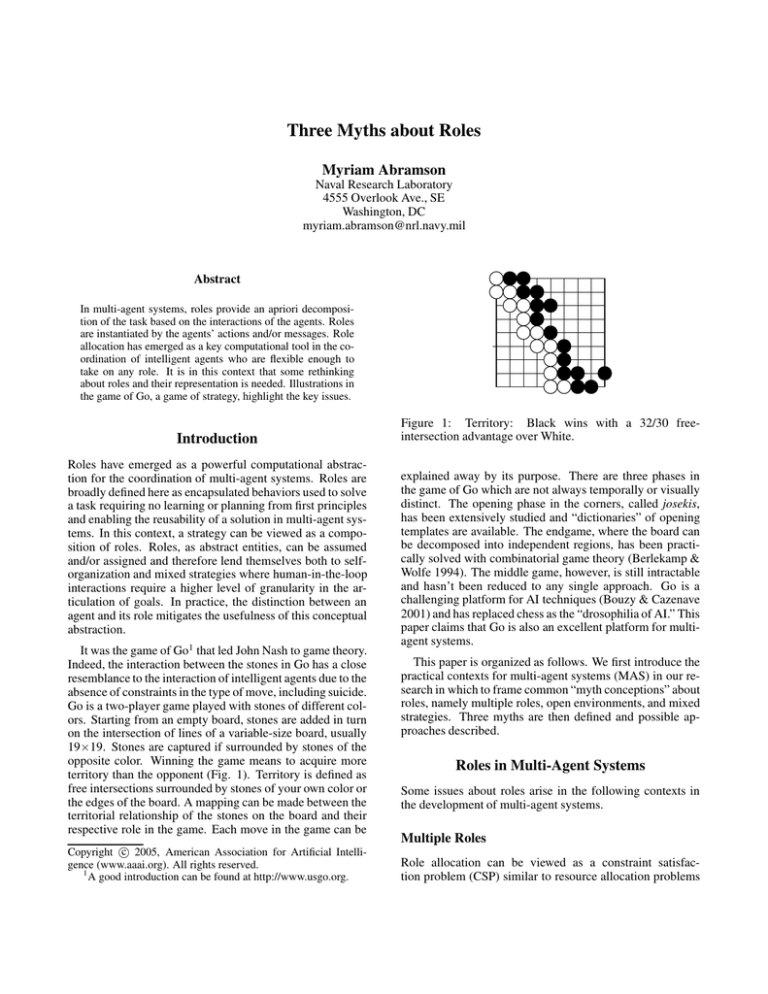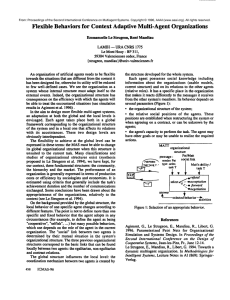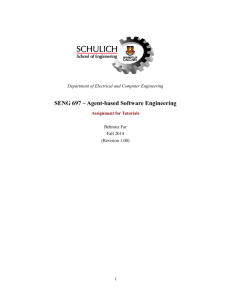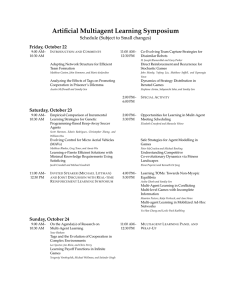
Three Myths about Roles
Myriam Abramson
Naval Research Laboratory
4555 Overlook Ave., SE
Washington, DC
myriam.abramson@nrl.navy.mil
Abstract
In multi-agent systems, roles provide an apriori decomposition of the task based on the interactions of the agents. Roles
are instantiated by the agents’ actions and/or messages. Role
allocation has emerged as a key computational tool in the coordination of intelligent agents who are flexible enough to
take on any role. It is in this context that some rethinking
about roles and their representation is needed. Illustrations in
the game of Go, a game of strategy, highlight the key issues.
Introduction
Roles have emerged as a powerful computational abstraction for the coordination of multi-agent systems. Roles are
broadly defined here as encapsulated behaviors used to solve
a task requiring no learning or planning from first principles
and enabling the reusability of a solution in multi-agent systems. In this context, a strategy can be viewed as a composition of roles. Roles, as abstract entities, can be assumed
and/or assigned and therefore lend themselves both to selforganization and mixed strategies where human-in-the-loop
interactions require a higher level of granularity in the articulation of goals. In practice, the distinction between an
agent and its role mitigates the usefulness of this conceptual
abstraction.
It was the game of Go1 that led John Nash to game theory.
Indeed, the interaction between the stones in Go has a close
resemblance to the interaction of intelligent agents due to the
absence of constraints in the type of move, including suicide.
Go is a two-player game played with stones of different colors. Starting from an empty board, stones are added in turn
on the intersection of lines of a variable-size board, usually
19×19. Stones are captured if surrounded by stones of the
opposite color. Winning the game means to acquire more
territory than the opponent (Fig. 1). Territory is defined as
free intersections surrounded by stones of your own color or
the edges of the board. A mapping can be made between the
territorial relationship of the stones on the board and their
respective role in the game. Each move in the game can be
c 2005, American Association for Artificial IntelliCopyright gence (www.aaai.org). All rights reserved.
1
A good introduction can be found at http://www.usgo.org.
Figure 1: Territory: Black wins with a 32/30 freeintersection advantage over White.
explained away by its purpose. There are three phases in
the game of Go which are not always temporally or visually
distinct. The opening phase in the corners, called josekis,
has been extensively studied and “dictionaries” of opening
templates are available. The endgame, where the board can
be decomposed into independent regions, has been practically solved with combinatorial game theory (Berlekamp &
Wolfe 1994). The middle game, however, is still intractable
and hasn’t been reduced to any single approach. Go is a
challenging platform for AI techniques (Bouzy & Cazenave
2001) and has replaced chess as the “drosophilia of AI.” This
paper claims that Go is also an excellent platform for multiagent systems.
This paper is organized as follows. We first introduce the
practical contexts for multi-agent systems (MAS) in our research in which to frame common “myth conceptions” about
roles, namely multiple roles, open environments, and mixed
strategies. Three myths are then defined and possible approaches described.
Roles in Multi-Agent Systems
Some issues about roles arise in the following contexts in
the development of multi-agent systems.
Multiple Roles
Role allocation can be viewed as a constraint satisfaction problem (CSP) similar to resource allocation problems
where agents are variables (x1 , ..., xn ) and roles are values
that those variables can take. When a utility or preference is
attached to an assignment, role allocation also entails a constraint optimization problem. There are typically N roles
and N agents and the goal is to maximize the sum of utilities
or Pareto efficiency in assigning agent xi to role j subject to
the constraint that xi∈N 6= xi0 ∈N −i . In dynamic environments with partial observability, this constraint must be relaxed and the optimization goal becomes elusive. The multiagent system problem can be formally described as follows:
• xi = j ←assignment of an agent i to role j
P
• uij ←utility of role j to agent i, where j uij = 1
P
• wj ←priority of role j in the global task, where j wj =
1
P
• Maximize i,j uij wj or Pareto efficiency of a solution
When the global task consists of multiple coordination tasks
and multiple teams coexist, an agent can take on multiple
non-conflicting roles. The goal is then to maximize
P P
t
i,j
uij wj
|N |
(1)
where t is the number of teams. Over-constrained situations where a team cannot be formed because of an insufficient number of agents are not relevant here. Rather,
an agent has to assume multiple roles in those situations.
The capability to handle multiple roles is an important aspect of the coordination of intelligent agents to achieve the
promised payoff of multi-agent systems. In order to extend
role allocation algorithms to multiple roles, the myth that
roles are “crisp”, that is distinct and non-overlapping, must
first be addressed.
Open Environments
Open environments are characterized by dynamic team formation, multiple and changing goals, non-deterministic state
transitions, variable resources, and unreliable communication (Abramson & Mittu 2004; Dastani, Dignum, & Dignum
2003). In this context, roles become fluid since the possibility of finding a better match for the role required exists.
The cost in switching roles, such as increased communication, must be balanced against possible benefits. In the
game of Go, as in open environments, stones can be added
at any time if free intersections remain and there is no limit
to the number of stones that can be played. In order to extend multi-agent systems to open environments, the myth
that roles are “static” must first be addressed.
Mixed Strategies
Roles provide the high-level granularity for a human-in-theloop type of strategy to direct the task while coordination
can occur at the lower level of primitive action selection.
In this context, it is not clear that only strategic level roles
A
Figure 2: Myth 1 - In this situation, ’A’ is the vital point for
White for both attacking and defending. (Tisheng & Wen
1983)
are those candidates for human intervention. The dichotomy
between tactics and strategy and where priorities lie is not
always clear. In the game of Go, strategic moves, called
fusekis, occur in the opening and affect the general outcome
of the game. However, an evaluation function of the moves
in Go has been so far elusive so that there is no guarantees of
winning the game after the initial strategic phase. This provides a dilemma on what should be brought up to the human
attention. In order to get some insights into this problem,
the myth that roles are “flat”, that is one-dimensional, either
tactical or strategic, must first be addressed.
Myth 1: Roles are “crisp”
Not only do we multitask out of necessity, but one highlight
of intelligence is flexibility and adaptability in our interactions towards our peers and the environment. Premature role
allocation leads to suboptimal situations and missed opportunities especially in an open environment. Maximum coordination efficiency is obtained when one action can fulfill multiple roles (Fig. 2). This suggests that coordination
problems should be addressed at a lower level of granularity by decomposing roles into primitive actions (Abramson
& Mittu 2004). Such an approach view roles at the spectrum of a continuum of primitive actions leading from largescale coordination to local teamwork. Another approach, the
token approach (Scerri et al. 2004), keeps non-conflicting
roles intact and delays commitment to a specific role but
does not directly address the problem of multiple role instantiations .
Myth 2: Roles are “static”
Sure, some roles are well-known apriori such as who drives
the car and who is a passenger in the car. But new roles
are constructed dynamically and created or destroyed all the
time to respond to the need for coordination (Brooks 1995).
That is the motivation given for the rise and fall of “organizations”. This suggests that roles have to be synthetized
on the fly to respond to dynamic situations affecting coordination (Fig. 3). In this context, roles are similar to goaldriven behaviors that can be incrementally learned or modified to perform a task. In addition, it was shown that the
A
Figure 3: Myth 2 - Dead stones can suddenly acquire an
important role. White can leverage from its (marked) dead
stones to kill black.(Tisheng & Wen 1983)
fluidity of roles enables better coordination effectiveness. If
all agents are running the same optimized algorithm, e.g.
distributed constraint satisfaction, they should arrive at the
same solution with a minimum of interference without the
need for a consensus albeit with increased communication
to share state information (Abramson, Chao, & Mittu 2005).
How often to share state information when communication
is unreliable while not contributing to congestion? Insect
societies, such as the honeybees, demonstrate a plasticity in
the division of labor of their members according to age and
environmental conditions. Response thresholds (Bonabeau,
Dorigo, & Theraulaz 1999) are a way of reacting efficiently
to environment conditions in order to tune or switch roles in
situations where the ownership of a role is not exclusive to
an agent. How to use stigmergy to save on communication
costs associated with role allocation in a dynamic environment?
B
Figure 4: Myth 3 - Whole board considerations makes a
“small” tactical move at B more “urgent” than the “big”
move at A.(Tisheng & Wen 1983)
Myth 3: Roles are “flat”
Roles structure interactions in relation to a goal. Roles can
be represented as adjacency relations within a conceptual
graph (Sowa 1984) relating agents in a task at the intentional
level but their extensions into actions and/or messages might
suggests different interpretations. CSP algorithms evaluate roles in relation to other roles but fail to take multiple
goals into account leading to planning considerations. Getting the right local context in which to evaluate roles enabling a satisficing solution is necessary but difficult to do
in a multi-agent system (Fig. 4). How much information
should be relayed to the agents in order to obtain the correct context? How fine-grained should the interactions be?
Similarly, in the game of Go, “whole-board” considerations
(Yang & Straus 1996) arise in the interplay between strategic
fusekis and tactical josekis in the opening (Fig. 5).
Tuple-space modeling (Gelernter 1985) is an attempt to
establish an apriori context for coordination tasks involving
communication while coordination graphs (Guestrin, Koller,
& Parr 2002) provides an apriori context for tasks not necessarily requiring communication. Peer-to-peer discovery is a
dynamic way of establishing the proper interaction context
between agents.
6
13 12
8
3 10
11 14 9
A B
7
6
13 12
8
3 10
11 14 9
A B
1
5
2
4
B is the correct move
4
1
7
5
2
A is the correct move
Figure 5: Interplay between fusekis (moves 1,2,3,4, and 5)
and josekis (upper left corner)(Yang & Straus 1996)
Conclusion
Although roles are a powerful computational tool, a flexible
granularity is needed to address the multiple-role problem in
intelligent agents. Some of the usefulness of roles as apriori
decomposition of tasks might be a limitation with new tasks
requiring on-the-fly synthetization of roles. While behaviors
are goal-oriented, roles are defined in relation to other roles
for the only purpose of coordination and might only indirectly relate to the task. Coordination in multi-agent systems needs to interleave the creation of new roles with role
allocation at the proper abstraction level.
The author wants to acknowledge useful discussions with
Joe Collins and Mike Stein.
References
Abramson, M., and Mittu, R. 2004. Multi-agent systems
in open environments. In Proceedings of the Workshop on
Large-Scale Coordination at the Third International Joint
Conference on Autonomous Agents and Multiagent Systems.
Abramson, M.; Chao, W.; and Mittu, R. 2005. Design and
evaluation of distributed role allocation algorithms in open
environments. In International Conference on Artificial Intelligence.
Berlekamp, E., and Wolfe, D. 1994. Mathematical Go:
Chilling Gets the Last Point. A.K. Peters, Wellesley, Massachusetts.
Bonabeau, E.; Dorigo, M.; and Theraulaz, G. 1999. Swarm
Intelligence: from Natural to Artificial Systems. Oxford
University Press.
Bouzy, B., and Cazenave, T. 2001. Computer go: An aioriented survey. Artificial Intelligence 132(1):39–103.
Brooks, F. 1995. The Mythical Man Month. AddisonWesley.
Dastani, M.; Dignum, V.; and Dignum, F. 2003. Roleassignment in open agent societies. In Autonomous Agents
and Multi-agent Systems.
Gelernter, D. 1985. Generative communication in linda.
ACM Transations on Programming Languages and Systems 7(1):80–112.
Guestrin, C.; Koller, D.; and Parr, R. 2002. Multiagent
planning with factored mdps. In Advances in Neural Information Processing Systems, volume 14.
Scerri, P.; Farinelli, A.; Okamoto, S.; and Tambe, M. 2004.
Token approach for role allocation in extreme teams: Analysis and experimental evaluation. In Proceedings of 2nd
IEEE International Workshop on Theory and Practice of
Open Computational Systems.
Sowa, J. F. 1984. Conceptual Structures. Addison-Wesley.
Tisheng, G., and Wen, L. 1983. Strategic Fundamentals in
Go. Yutopian Enterprises.
Yang, Y., and Straus, P. 1996. Whole Board Thinking in
Joseki. Fourth Line Press.





